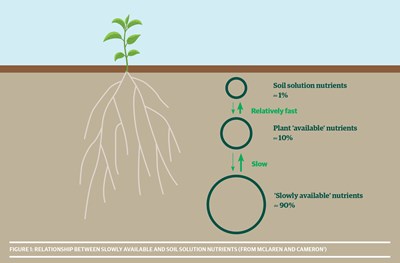Monday, 15 February 2021
Your soils – a cornucopia of nutrients?

Wouldn’t it be fantastic if the soils on your farm provided an endless supply of nutrients that you never had to supplement with any fertiliser? Imagine your farm was a highly productive and resilient enterprise producing highly nutritious, healthy plant and animal products, with little environmental impact, while profitably sustaining your family and local community. Unfortunately, this utopian vision and reality do not always align.
I recently heard an organic farmer tell a meeting in Ashburton not to believe soil tests because there was a heap more nutrients in the soil than what they indicated, and he was partly right.
If we were to take soil from your farm and treat it with strong acids and oxidising agents so that everything was dissolved, we would have a liquid containing a considerable concentration of nutrients. Depending on the mineral composition of the soil parent-material, it would be much higher than the amounts extracted by the traditional soil tests taken to assess your soil fertility. However, about 90% of the total amount of nutrients1 measured are either not immediately available or, at best, some are very slowly available over long time frames (Figure 1). This is because the nonavailable nutrients form the structure of the soil matrix. To access all the nutrients in the soil you would have to destroy the soil completely.
Only about 10% of the total nutrients measured in the soil are immediately plant ‘available’ nutrients1 and these often need to undergo various chemical, biochemical or biological transformations in the soil to enable the plant roots to access these nutrients. Soil tests are designed to extract the nutrients in soil solution and a proportion of the plant available pool1. Soil tests are not quantitative but qualitative. To interpret what they mean so management actions can be taken, the tests must be calibrated using a large number of field trials to compare soil test levels against pasture or crop yields.
The importance of soil biology in terms of the availability of soil nutrients is much talked about, and rightly so. Soil biology, i.e. bacteria, fungi, earthworms, nematodes and soil insects, all play an important role in soil function, but they are equally bound by a First Law of Thermodynamics-like situation; i.e. energy can neither be created nor destroyed but can change form. In terms of nutrients, soil biology cannot create nutrients, but it can change them from one form to another. For example, many micro-organisms mineralise organic matter as an energy source by using and/ or releasing the C, N and mineral elements that organic matter contains in the process. Other specialised micro-organisms produce phosphatase enzymes, which can solubilise P from minerals containing P in the soil thus making the plant P available. Fungi, such as ventricular arbuscular mycorrhiza (VAMs) infect plant roots, explore a greater volume of soil and recover nutrients, including P, which they supply to the plant2. So, rather than creating new sources of nutrients, these processes tap into nutrient sources already in the soil that would not have been readily plant available.
A study examining P cycling in pastures showed that organic forms of P accumulated in both unfertilised and fertilised soil and that the immobilisation of inorganic P (available to plants) into organic forms (not immediately available to plants) was a significant factor in fertiliser P requirements3, such that when no fertiliser (1,2,3) see Source Code page 40 By Dr Ants Roberts P was applied plant available P status declined. However, seasonal variations in the storage and release of P by organic matter and the microbial biomass was shown to occur during times of rapid pasture growth3.
In New Zealand we do not typically apply many of the essential trace elements such as iron, manganese, zinc and copper (for plant growth) because our geologically young soils contain enough of these in plant available forms such that we would not get a response to adding any. Sometime in the future the soil reserves of these elements may also run down and then we will need to apply them.
Despite what some people believe, no matter how numerous, active and diverse the soil biology is, nor how many diverse species of plants are growing in blissful harmony (with root systems exuding all manner of elicitors and bioactive substances at different depths in the soil profile), this will not create new nutrients.
The inescapable fact is that if those plants are harvested (by machine or animal) and removed from the location they are grown in, then eventually soil nutrients will be depleted to the point where it will be inevitable that externally sourced nutrients will need to be applied to sustain the soil‘s life-supporting capacity

